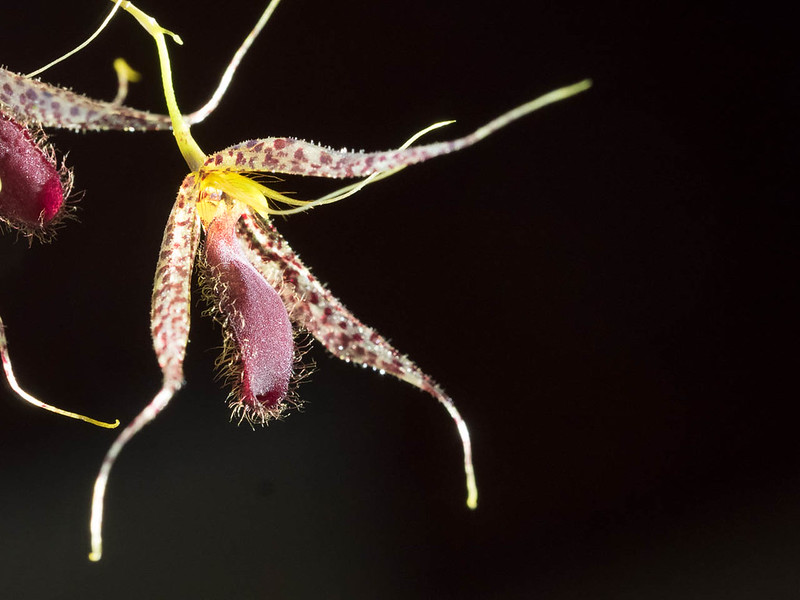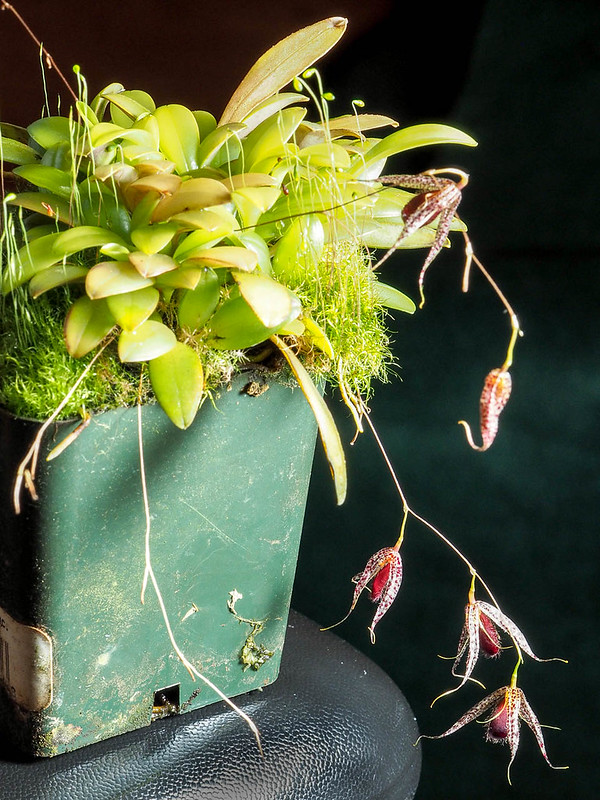
Muscarella megalops occurs in a relatively small area in south-western Ecuador in provinces of Azuay, El Oro and Loja at elevations of around 1600-2600m (Parsons and Gerritsen, 2013). In nature, it is a rare species (Luer 2006). Fortunately, this fascinating miniature species is fairly available and popular in cultivation.
The genus name of this species have been changed a couple times because the systematics of Pleurothallids has been revisited extensively in recent years. This species was originally described as Pleurothallis in 1982 by Luer. Subsequently, Pridgeon & Chase (2001) and Pridgeon (2005) placed it under Specklinia. Luer (2006) proposed that it should be under Muscarella. A molecular phylogeny based on nrITS and matK clearly supports Luer's proposition (Karremans et al, 2016), and it shows that ramping Muscarella species into genus Specklinia is not a good idea (see the following figure of phylogeny).
Karremans (2016) proposed nine major clades (affinities) within the Pleurothallidinae based on molecular phylgoeny. Muscarella is included in the affinity Specklinia, which contains 6 other genera: Andinia, Dryadella, Platystele, Scaphosepalum, Specklinia, and Teagueia. Here are the relationships among these 7 genera, based on Karremans et al. (2016) and Karremans (2016):
 |
| Phylogenetic relationships of genera within the affinity Specklinia. Drawn by TreeVector with the input in Newick format: (Andinia,(Dryadella,(Muscarella,(Specklinia,(Platystele,(Scaphosepalum,Teagueia)))))); |
This species does not have large flowers, but it is a good size for the small size of the plant. Within this genus, this species seems to have the largest leaves and flowers (Luer 2006). Indeed, the species epithet, megalops, is derived from greek: megalos (great) + ops (appearance), which is referring to the large lip (Luer 2006). As a side note, Megalops is a genus name of the ultimate flyfishing target, Atlantic Tarpon (Megalops atlanticus). The flower looks like an insect to me; the hairy lip is the abdomen, the lateral sepals are the wings, and the petals are the antennae. As with most species in this group, the mechanism of pollination is not known yet.

The next side-view photo unfortunately ended up with unnatural, pitch-black background, which I try to avoid if I can. but you can clearly see the long hairs attached to the petals (compare it to Luer's illustration below). Some insects have this kind of branched antennae, and I wonder if this detail has some functionality of mimicing.

In the magnified view, you can somewhat see how the long petal hairs are attached. Also notice that there is an eye-like structure at the base of the petal (see the right side of the flower, near the very edge of the photo).

 |
| © Missouri Botanic Garden 2006. Muscarella megalops (Luer) Luer. (link). From Luer (2006) Icones Pleurothallidinarum XXVIII. Swiss Orchid Foundation at the Herbarium Jany Renz. Botanical Institute, University of Basel, Switzerland. |
When I received it from Ecuagenera in 2014, I was growing at the cool end of intermediate temperature (night temperature of 13C (55F) in the winter and 18C (65F) in the summer) for a half year or so, but it didn't like it. I thought that I failed acclimation and lost it, but it started to recover slowly after I moved it to a colder area, where I'm growing cold growing species like Telipogon species and Masdevallia racemosa. Here is a link to my growing condition (see the very bottom of this post). One thing I noticed is that the leaves become smaller with this colder condition: 20C (68F) day, 10C (50F) night although it grows well and in flower continuously. Luer (2006) stated that the leaves are 30-45mm long. Originally, it was around 35mm (you can see 2 larger yellowing leaves which are probably the left-over from the original plant), but they are more like 25mm now. My plant seems to be growing ok, but it looks a little yellowish, and I wonder if it wants more fertilizer.
 |
| Whole plant. It is in a 2" pot. |
Literature cited:
- Karremans, A.P., 2016. Genera Pleurothallidinarum: an updated phylogenetic overview of Pleurothallidinae. Lankesteriana, 16(2). (PDF link)
- Karremans, A.P., Albertazzi, F.J., Bakker, F.T., Bogarin, D., Eurlings, M.C., Pridgeon, A., Pupulin, F. and Gravendeel, B., 2016. Phylogenetic reassessment of Specklinia and its allied genera in the Pleurothallidinae (Orchidaceae) Phytotaxa 272 (1): 1-36 (link)
- Luer, C.A. 2006 Icones Pleurothallidinarum Vol XXVIII. Monographs in Systematic Botany from the Missouri Botanical Garden 105: 113, f. 76.
- Parsons, R. and M. E. Gerritsen. 2013. A Compendium of Miniature Orchid Species. Volume 2, p. 923. Redfern Natural History Productions
- Pridgeon, A.M. & Chase, M.W. 2001. A phylogenetic reclassification of Pleurothallidinae (Orchidaceae). Lindleyana 16: 235–271.
- Pridgeon, A.M. 2005. Subtribe Pleurothallidinae. In: Pridgeon, A.M., Cribb, P.J., Chase, M.W. & Rasmussen, F.N. (Eds.) Genera Orchidacearum. Volume 4 Epidendroideae (Part One). Oxford University Press, Oxford, pp. 405–412.
Comments
Post a Comment